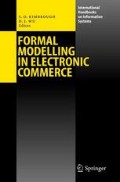Abstract
Communicative workflow modelling is key to describing, analyzing, and designing business procsses in virtual collaborative networks, such as present in e-commerce. To make workflow models meaningful and acceptable to all partners, their legitimacy must be ensured. To this purpose, the underlying norms must be made explicit and used to check model acceptability. A key class of communicative workflow models are captured by our extended workflow loop. Using this loop as the basic unit of analysis, we introduce the concept of workflow loop norms, grounded in, amongst others, internal control theory. Workflow loop schemas are used to represent workflow situations, allowing for actual or proposed situations to be matched with the norms. Using these constructs, we outline our legitimacy checking process for workflow designs, and illustrate it with a case.
Access this chapter
Tax calculation will be finalised at checkout
Purchases are for personal use only
Preview
Unable to display preview. Download preview PDF.
References
W.M.P. van der Aalst, Three good reasons for using a Petri-net-based workflow management systems, Information and Process Integration in Enterprises: Rethinking Documents (Toshiro Wakayama, Srikanth Kannapan, Chan Meng Khoong, Shamkant Navathe, and JoAnne Yates, eds.), Kluwer Academic Publishers, Dordrecht, The Netherlands, 1 December 1997, pp. 179–201.
David E. Avison and Guy Fitzgerald, Where now for development methodologies?, Communications of the ACM 46 (2003), no. 1, 78–82.
P. Baumard, Tacit knowledge in organizations, Sage, London, UK, 1999.
Roger W.H. Bons, Designing trustworthy trade procedures for open electronic commerce, Ph.D. thesis, EURIDIS at Erasmus University, Rotterdam, The Netherlands, September 1997.
K. T. Chen, Schematic evaluation of internal accounting control systems, Ph.D. thesis, University of Texas at Austin, Austin, Texas, 1992.
Aldo de Moor and Manfred A. Jeusfeld, Making workflow change acceptable, Requirements Engineering 6 (2001), no. 4, 75–96.
B. de Wit and M. van Delden, Performance analysis of internal communication: A research approach for assessing the quality of policy and motivating communication, The Quality of Communication in Organisations in Theory and Practice (J. A. de Ridder and K. Seisveld, eds.), Cramwinckel, Amsterdam, The Netherlands, 1996, Translated from Dutch.
J. Dietz and V. Van Reijswoud, DEMO modelling handbook, Technical report, 1998, Volume 2.
Aldo de Moor and W. J. van den Heuvel, Making virtual communities work: Matching their functionalities, Proceedings of the 9th International Conference on Conceptual Structures (Palo Alto, CA), Stanford University, July 30–August 3, 2001.
D.C.L. Kuo and M. Smits, Performance of integrated supply chains: An international case study in high tech manufacturing, Proceedings of the 36th Hawaii International Conference on System Sciences (HICSS-36) (Ralph H. Sprague, Jr., ed.), IEEE Computer Society Press, Los Alamitos, CA, January 2003, (CD-ROM).
G. Luger and W. Stubblefield, Artificial intelligence and the design of expert systems, Benjamin-Cummings, Redwood City, CA, 1989.
K. Liu, L. Sun, A. Dix, and M. Narasipuram, Norm-based agency for designing collaborative information systems, Information Systems Journal 11 (2001), no. 3, 229–247.
P. Lyman, How is the medium the message? notes on the design of networked communication, Computer Networking and Scholarly Communication in the Twenty-First Century University (T. Stephen, ed.), State University of New York Press, New York, NY, 1996, pp. 39–52.
Raul Medina-Mora, Terry Winograd, Rofrigo Flores, and Fernando Flores, The action workflow approach to workflow management technology, The Information Society 9 (1993), no. 4, 391–404.
Wanda Orlikowski and JoAnne Yates, Genre systems: Structuring interaction through communicative norms, Working paper CCS WP #205, Sloan WP #4030, Massachusetts Institute of Technology, Sloan School of Management, Cambridge, MA, July 1998, http://ccs.mit.edu/papers/CCSWP205/index.html, accessed 22 August 2004.
T. Schäl, Workflow management systems for process organizations, Springer Verlag, June 1996.
John F. Sowa, Conceptual structures: Information processing in mind and machine, Addison-Wesley, Reading, MA, 1984.
F. van der Poll, H. Weigand, and A. de Moor, Communication diagnosis of a financial service process, Proceedings of the Seventh International Workshop on the Language-Action Perspective on Communication Modelling (Delft, The Netherlands), LAP-2002, June 12–13, 2002, pp. 118–134.
Hans Weigand and Aldo de Moor, Workflow analysis with communication norms, Data & Knowledge Engineering 47 (2003), 349–369.
Terry Winograd and Fernando Flores, Understanding computers and cognition: A new foundation for design, Addison-Wesley Publishing Company, Reading, Massachusetts, 1987.
Author information
Authors and Affiliations
Editor information
Editors and Affiliations
Rights and permissions
Copyright information
© 2005 Springer-Verlag Berlin Heidelberg
About this chapter
Cite this chapter
de Moor, A., Weigand, H. (2005). Legitimacy Checking in Communicative Workflow Design. In: Kimbrough, S.O., Wu, D. (eds) Formal Modelling in Electronic Commerce. International Handbooks on Information Systems. Springer, Berlin, Heidelberg. https://doi.org/10.1007/3-540-26989-4_3
Download citation
DOI: https://doi.org/10.1007/3-540-26989-4_3
Publisher Name: Springer, Berlin, Heidelberg
Print ISBN: 978-3-540-21431-1
Online ISBN: 978-3-540-26989-2
eBook Packages: Business and EconomicsBusiness and Management (R0)

